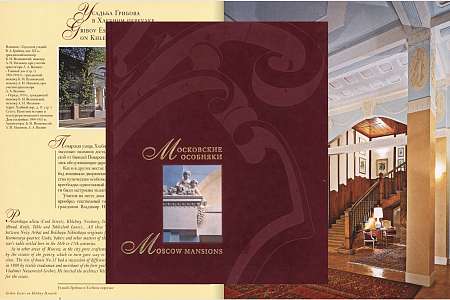





Along with the "new art", modern the new ideas for organizing the urban space came in Moscow. People who lived in a built-up multi-storey city center lacked coziness, chamber private space. This was one of the reasons of high demand for modern – an architectural style focused on establishing an integral, artistically meaningful living environment. Due to this style, the history of the city has a remarkable, yet short period, when the center of the city was built with small comfortable villas.
At first the objective to build "urban villas" in the center of Moscow was announced by "Northern Homebuilding Association" headed by the famous industrialist and benefactor Savva Mamontov. The Association tried to use the cutting-edge architectural ideas in the everyday practice of construction in Moscow. Despite their European origin, those ideas were largely a mere update of ancient traditions of urban manors.
For the first buildings of the Association Mr. Mamontov chose modern, which could attract rich clients who already saw the recent buildings authored by fashionable architects of France and Belgium. Unfortunately, due to various reasons, the "Northern Association" could not put into practice its manifests, however, their ideas were heard and embodied "in stone" by other major construction company of Moscow – "Moscow Trade and Construction Joint-Stock Company". Its founder and the largest shareholder Jacob Andreyevich Reck combined vigorous entrepreneurial realism with a touch of romance, which all reflected in his buildings. For a pretty short period of time this company built in Moscow at least 15 houses, among which were luxurious mansions on Povarskaya Street and Granatny Pereulok, guest houses in Prechistenka, commercial premises in Nikolskaya and Myasnitskaya streets.
In 1903 the Company commenced the "turn-key" construction of two mansions in modern style instead of an old urban manor in Povarskaya Street – based on the design of a venerable Moscow architect Lev Nikolayevich Kekushev. The construction was finished in 1904 and the buildings remained in the ownership of "Moscow Trade and Construction Joint-Stock Company" almost till the end of 1900-s. Later house No.44 was purchased by a rich Upper Volga textile manufacturer Ivan Aleksandrovich Mindovsky. By that time the building had been already recognized as an example of modernism architecture. The urban manor on the corner of Povarskaya Street and Skariatinsky Pereulok rose above all other buildings, drawing attention with its rounded walls, huge windows, curved roofing and the only tremendous chargrill light in the neighborhood...
In 1918 all the estates, factories and manors of the Mindovskys were nationalized. It was a hard time of changing owners for many Moscow mansions. However, Mindovsky's mansion had a relatively fortunate destiny – it avoided constant alterations, reconstructions and renovations accompanied with the destruction and the loss of the initial decoration. Since 1924 Swedish mission has been here, then – the Embassy of Sweden in the USSR. The new owners treated their new home with care, trying to conserve the elements of architectural décor, and not to rebuild the private quarters without need. Eventually, the building became too small for Swedish Embassy and in 1972 it moved to a new complex in Mosfilmovskaya Street.
The Embassy of New Zealand has been located in the mansion since 1972. Over these years the interiors of the mansion were altered and updated many times. In the recent years a large-scale restoration of the mansion has been carried out and the representative mission of New Zealand was awarded a prize of Moscow Government "For respect of Russian culture".

 Laureate of the Moscow Restoration 2019 competition: For the best organization of repair and restoration work at cultural heritage sites.
Laureate of the Moscow Restoration 2019 competition: For the best organization of repair and restoration work at cultural heritage sites.
In 2019, GlavUpDK under the MFA of Russia returned the original historical appearance to the ensemble on Povarskaya Street.
Thanks to careful operation and regular maintenance works carried out before the start of a big restoration, the building was in a satisfactory condition and retained many of its original elements.
Based on the results of historical and cultural research, the study of archival photos, certificates, drawings and the use of preserved samples, the original layout of the beginning of the 20th century, the Monier vaults in the basement of the courtyard extension and the lost elements of interiors and façades, as well as the façades proper, wrought iron fence with gates and a wicket door, and complex-shaped roofs – all unique in their richness and expressiveness – were restored in the mansion.
During the work, restorers found real discoveries. For example, during opening of the ceilings and removal of late finishes, the following were discovered and completely restored: ceiling moldings made in various styles for each hall, monumental paintings and stained glass panels. The original color scheme of the interiors and the façades was recreated, including restoration of the discovered gilding. The original oak parquet on the second floor was also restored. Restoration of historical lighting fixtures (chandeliers of the main staircase, numerous sconces, lamps and unique girandoles welcoming guests at the main entrance), multi-figure sculptural bas-reliefs referring us to the motives of antiquity, the grand marble staircase with the spelter fencing with lion masks and the unique onyx fireplace, was carried out. In the dining room, the plafond with spot lighting and the central panel painting with a plot typical of the Art Nouveau style were recreated.
The restoration of the stained glass windows of the mansion deserves special mention. So, the huge stained glass of the dining room, which was badly damaged in the first half of the 20th century, was saved. The stained glass windows of the main staircase and the entrance hall were cleared and re-arranged to amaze the public again.
During inspection of the winter garden, the following were discovered: the suspended metal ceiling filled with multicolored cabochons forming an intricate ornament, the decoration of walls with blue glazed tiles hidden under layers of plasterwork, paint and wallpaper.
A milestone event for lovers of Moscow architecture was the return of the sculptural group destroyed in the 1920s to the southern façade of the mansion. A three-meter-high three-dimensional sculpture, rare for Moscow, represents the muse of painting with a palette and a brush in her hands and two babies. The reconstruction of the group was carried out using the method of graphic constructions based on archival materials and additional full-scale studies.
Fireplace chimneys of the building were restored with the installation of smokestacks on them according to archival photographs. Above the service entrance of the northern façade of the building a wrought iron canopy using the motif of the mansion’s decor was erected. Specialists also recreated the lost balcony of the northern façade and restored the marble arch of the main entrance, located directly under the balcony.
The completed works, including modern engineering systems and equipment, meet regulatory requirements, ensure safety, comfort and ease of operation of the building.
In 2019, GlavUpDK under the MFA of Russia was announced the winner of the Moscow Restoration competition for the best organization of repair and restoration work.